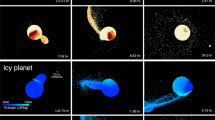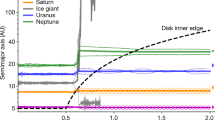Abstract
The Moon is generally believed to have formed from the debris disk created by a large body colliding with the early Earth1,2. Recent models of this process predict that the orbit of the newly formed Moon should be in, or very near, the Earth's equatorial plane3,4. This prediction, however, is at odds with the known history of the lunar orbit: the orbit is currently expanding, but can be traced back in time to reveal that, when the Moon formed, its orbital inclination relative to the Earth's equator was I ≈ 10° (refs 5, 6). The cause of this initial inclination has been a mystery for over 30 years, as most dynamical processes (such as those that act to flatten Saturn's rings) will tend to decrease orbital inclinations. Here we show that the Moon's substantial orbital inclination is probably a natural result of its formation from an impact-generated disk. The mechanism involves a gravitational resonance between the Moon and accretion-disk material, which can increase orbital inclinations up to ∼15°.
This is a preview of subscription content, access via your institution
Access options
Subscribe to this journal
Receive 51 print issues and online access
$199.00 per year
only $3.90 per issue
Buy this article
- Purchase on Springer Link
- Instant access to full article PDF
Prices may be subject to local taxes which are calculated during checkout


Similar content being viewed by others
References
Cameron, A. G. W. & Ward, W. R. The origin of the Moon. Lunar Sci. VII, 120–122 (1976).
Hartmann, W. K. & Davis, D. R. Satellite-sized planetesimals and lunar origin. Icarus 24, 504–515 (1975).
Canup, R. M. & Esposito, L. W. Accretion of the Moon from an impact-generated disk. Icarus 119, 427–446 (1996).
Ida, S., Canup, R. M. & Stewart, G. Formation of the Moon from an impact-generated disk. Nature 389, 353–357 (1997).
Goldreich, P. History of the lunar orbit. Rev. Geophys. 4, 411–439 (1966).
Touma, J. & Wisdom, J. Evolution of the Earth-Moon System. Astron. J. 108, 1943–1961 (1994).
Cameron, A. G. W. & Benz, W. The origin of the Moon and the single impact hypothesis IV. Icarus 92, 204–216 (1991).
Cameron, A. G. W. The origin of the Moon and the single impact hypothesis V. Icarus 126, 126–137 (1997).
Cameron, A. G. W. & Canup, R. M. The giant impact occurred during Earth accretion. Lunar Planet. Sci. XXIX, 1062–1063 (1998).
Touma, J. & Wisdom, J. Resonances in the early evolution of the Earth-Moon system. Astron. J. 115, 1653–1663 (1998).
Ward, W. R. & Cameron, A. G. W. Disc evolution within the Roche limit. Lunar Planet Sci. IX, 1205–1207 (1978).
Kokubo, E., Ida, S. & Makino, J. Evolution of a circumterrestrial disk and formation of a single moon. Icarus (submitted).
Thompson, C. & Stevenson, D. Gravitational instability in two-phase disks and the origin of the Moon. Astrophys. J. 333, 542–481 (1983).
Shu, F. in Planetary Rings (eds. Greenberg, R. & Brahic, A.) 513–561 (Univ. Arizona Press, Tucson, 1984).
Elliot, J. L. & Nicholson, P. D. in Planetary Rings (eds Greenberg, R. & Brahic, A.) 25–72 (Univ. Arizona Press, Tucson, 1984).
Goldreich, P. & Tremaine, S. Disk-satellite interactions. Astrophys. J. 241, 425–441 (1980).
Borderies, N., Goldreich, P. & Tremaine, S. Excitation of inclinations in ring-satellite systems. Astrophys. J. 284, 429–434 (1984).
Ward, W. R. & Hahn, J. M. Damping of orbital inclinations by bending waves. Icarus 110, 95–108 (1994).
Meyer-Vernet, N. & Sicardy, B. On the physics of resonant disk-satellite interaction. Icarus 69, 157–175 (1987).
Ward, W. R. & Hahn, J. M. The eccentricity of Neptune and the nature of the Kuiper belt. Science 280, 2104–2106 (1998).
Tremaine, S. Resonant relaxation in protoplanetary disks. Astron. J. 116, 2015–2022 (1998).
Brouwer, D. & Clemence, G. M. Methods of Celestial Mechanics (Academic, New York, 1961).
Boss, A. P. & Peale, S. J. in Origin of the Moon (eds Hartmann, W. K., Phillips, R. J. & Taylor, G. J. (Lunar and Planetary Institute Press, Houston, 1986).
Acknowledgements
We thank L. Dones, D. Stevenson, G. Stewart and J. Wisdom for comments, and A. G. W. Cameron for data from his SPH impact simulations. This work was supported by NASA's Planetary Geology and Geophysics, and Origins of Solar Systems, Programs.
Author information
Authors and Affiliations
Corresponding author
Rights and permissions
About this article
Cite this article
Ward, W., Canup, R. Origin of the Moon's orbital inclination from resonant disk interactions. Nature 403, 741–743 (2000). https://doi.org/10.1038/35001516
Received:
Accepted:
Issue Date:
DOI: https://doi.org/10.1038/35001516
This article is cited by
-
Tidal evolution of the Moon from a high-obliquity, high-angular-momentum Earth
Nature (2016)
-
Collisionless encounters and the origin of the lunar inclination
Nature (2015)
-
The Moon's tilt for gold
Nature (2015)
Comments
By submitting a comment you agree to abide by our Terms and Community Guidelines. If you find something abusive or that does not comply with our terms or guidelines please flag it as inappropriate.



